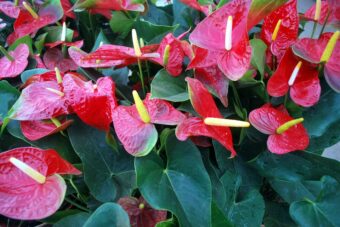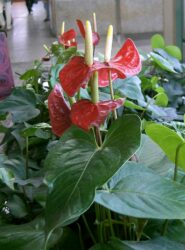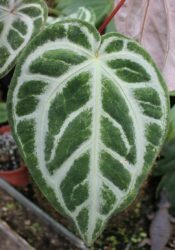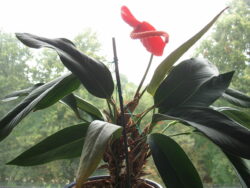In this article, we will be discussing how to grow and get the best from your anthurium houseplants. Anthuriums tend to be grown for their sparkling ‘flowers’ that can last for months, but it can be easily grown for their large deep green, glossy leaves of many forms. They are from the family Araceae (the arum family).

I will tell you a secret, the flowers are not flowers but the red, white, pink or purple are leaves called spathes that come from the base of the plant, where the real, tiny flowers appear.
It is a plant that is not the easiest to grow, but it is well worth the effort if you follow what is written in this article.
In this article, we will talk about the basic anthurium requirements, the varieties to grow and the pitfalls to avoid.
WHAT IS AN ANTHURIUM?
Anthuriums is a genus of around 1000 species that are native to Central America, South America, and the Caribbean. In mild, warm areas, it is grown as an outdoor plant but in many temperate climates, it is a plant to grow in the home.
As said in the introduction the plants are grown for the colourful spathes, whilst some are grown for their large, deep green leaves of multiple forms. They are climbers in the native lands but not much so in homes, where they need to be misted and need warmth and high humidity to do well.

Most houseplant anthuriums grow up to 60cm high, so they are not very tall houseplants suitable for even the smallest of homes. If you notice that you anthuriums plants are flopping all over the place, do not worry as the plant tend to grow in the air (they are epiphytes) and prefer to grow on other plants instead of the soil. To prevent this, you can support the plant with a good support cane structure.
They are colourful, beautiful to look at and next we will find out how to grow them.
THE BEST GROWING CONDITIONS FOR ANTHURIUM
LIGHT
Anthurium plants like to be grown in a bright, well-lit spot but away from direct sunlight, as this can burn the leaves.
TEMPERATURE
Unlike a lot of houseplants that require warm temperature, Anthuriums prefer temperatures from 16 to 22 degree Celsius. It does not require very warm room temperatures to survive. If the temperature falls below this, it will not be happy and it will start to lose leaves and look sad.
COMPOST

Ideally, a mix made from orchid compost mixed with a few handfuls of horticultural grit should be used. Do repot your anthurium to this mixture once the plant has become root-bound. This can occur every one to two years where the aerial roots begin to appear above the compost level. Once this is seen then most definitely the plant will need to be repotted on to a pot that is the next size up. This is also a good time to propagate new plants by division or via these aerial roots.
An easy way to propagate new anthuriums is by cutting the aerial roots, dip them in rooting hormone powder and then plant them in a new growing media. Within 2 months new stems and leaves should appear.
WATERING
The compost must always be slightly moist and must never be allowed to dry out completely. It is best to water when 5cm below the top of the surface of the compost feels dry to the touch when you stick your finger in. Water until it just appears at the drainage holes.
HUMIDITY
In their natural tropical growing conditions these plants like high humidity at all times. Thoroughly mist them regularly or try growing them on a tray of moist expanded clay balls, especially in dry, central heated homes.
FERTILIZER
During the growing season from March to September use a general houseplant fertilizer and use it at half strength to feed the plant every 2 weeks. In winter, do not feed at all.
VARIETIES TO GROW
In general, there are three varieties to grow in the home.
ANTHURIUM ANDRAEANUM (Painter’s Palette, Flamingo Flower)
This is often known as a wax flower or oilcloth flower because of the texture of the glossy green. It is a plant that grows up to 45cm in height and needs good light in winter. Slight shade in summer, as you do not want to scorch the leaves.
ANTHURIUM CRYSTALLINUM (Crystal Anthurium)
This is a plant with large heart-shaped leaves that are purplish whilst young and have a crystalline sheen. Any aerial roots that form at the bottom must be covered well in moist compost as they grow. Otherwise, the plant will not do very well.
ANTHURIUM SCHERZERIANUM (Flamingo Flower)

This is a popular species with attractive red waxy-textured leaves that appear from leaves. The spathes are bright red, white or pink in colour, where the oval leaves are spring to autumn. The leaves are spear-shaped and it only grows up to 23cm in height. Do not plant these plants too deep as this may cause the base to rot. A compact and more manageable Anthurium
Other less common varieties include: A. hookeri, A. radicans, A. pedaroradiatum, A. clarinervium and A. magnificum
Keep the plants away from draughts locations and from bright sun that can cause the leaves to turn pale. Get the watering right and more importantly the humidity and you will do fine. Looks out for pests such as spider mites and mealybugs, where they need to be treated with a systemic insecticide. Be persistence as they can take a while.
CONCLUSIONS
In this article, we have discussed the best way to look after anthuriums from the varieties to grow and the best growing conditions to rear them in. They are not easy plants to look after- they need constant warmth and high humidity to survive and flourish
The beauty of these plants is well worth the effort in looking after them. A plant that you will be proud to display in your home, be it for the colourful leaves or those that produce colourful spathes.
If you have any questions or comments that you wish to make, please do so in the comment box below.
Grow anthuriums in your home today.
